Experimental Study and Practical Application of Existing Crack Repair in Concrete Dam Tunnels Using MICP and EICP
Abstract
1. Introduction
2. Crack State of the Tunnel Subjected to Repair
3. Repair Solution Preparation and Laboratory Tests
3.1. Preparation of Repair Solutions
3.2. Laboratory Tests
3.3. Application of Repair Solution onto the Cracks Located in the Tunnel
3.4. Evaluation of Bacteria and Cured Urease Activity
3.5. Acid-Washing Evaluation of Calcium Carbonate Content
3.6. Crystallography of Precipitated Calcium Carbonate—XRD
3.7. Morphology of Precipitated Calcium Carbonate—SEM
4. Results and Discussion
4.1. Precipitation of Calcium Carbonate in Tunnel’s Crack
4.2. Bacteria and Enzyme Urease Activity
4.3. Content of Calcium Carbonate in Precipitated Material
4.4. XRD–Outcome
4.5. Morphology of CaCO3
4.6. Comparison with Other Repair Strategies
5. Conclusions
- 1.
- Both approaches are sustainable alternatives to conventional cementitious/epoxy repair, offering reduced environmental impact and technical feasibility in field applications. MICP offers long-term stability advantages, while EICP provides simpler preparation and faster precipitation.
- 2.
- MICP was more effective in sealing narrow cracks by utilizing microbial cells as localized nucleation sites, while EICP achieved more uniform filling of wider or irregular cracks owing to better dispersibility of the enzyme solution.
- 3.
- XRD and SEM analyses confirmed distinct mineralogical and morphological features. MICP produced mixed vaterite–calcite phases with irregular, biologically influenced clusters, whereas EICP yielded predominantly calcite with smoother and more uniform spherical deposits.
Author Contributions
Funding
Data Availability Statement
Acknowledgments
Conflicts of Interest
References
- Fan, Q.; Jiang, X.; Wang, K.; Huang, C.; Li, G.; Wei, P. Cement grouting online monitoring and intelligent control for dam foundations. J. Intell. Constr. 2023, 1, 1–15. [Google Scholar] [CrossRef]
- Wang, Z.; Mao, Y.; Tan, Y.; Shen, Q.; Xu, H. A safety evaluation method and system for a high core wall dam based on construction data. J. Intell. Constr. 2025, 3, 1–14. [Google Scholar] [CrossRef]
- Kim, M.O.; Bordelon, A.; Lee, M.K.; Oh, B.H. Cracking and failure of patch repairs in RC members subjected to bar corrosion. Constr. Build. Mater. 2016, 107, 255–263. [Google Scholar] [CrossRef]
- Kim, M.O.; Bordelon, A.C.; Lee, N.K. Early-age crack widths of thin fiber reinforced concrete overlays subjected to temperature gradients. Constr. Build. Mater. 2017, 148, 492–503. [Google Scholar] [CrossRef]
- Kim, M.O.; Bordelon, A. Determination of total fracture energy for fiber-reinforced concrete. Spec. Publ. 2015, 300, 1–16. [Google Scholar]
- Neville, A.M. Properties of Concrete, 5th ed.; Pearson Education Limited: Essex, UK, 2011. [Google Scholar]
- Pacheco-Torgal, F.; Jalali, S.; Fucic, A. Toxicity of Building Materials; Woodhead Publishing: Cambridge, UK, 2012. [Google Scholar]
- Mehta, P.K.; Monteiro, P.J.M. Concrete: Microstructure, Properties, and Materials, 4th ed.; McGraw-Hill Education: New York, NY, USA, 2014. [Google Scholar]
- Kayondo, M.; Combrinck, R.; Boshoff, W.P. State-of-the-art review on plastic cracking of concrete. Constr. Build. Mater. 2019, 225, 886–899. [Google Scholar] [CrossRef]
- Golewski, G.L. The Phenomenon of Cracking in Cement Concretes and Reinforced Concrete Structures: The Mechanism of Cracks Formation, Causes of Their Initiation, Types and Places of Occurrence, and Method of Detection—A Review. Buildings 2023, 13, 765. [Google Scholar] [CrossRef]
- Aldea, C.M.; Shah, S.P.; Karr, A. Effect of cracking on water and chloride permeability of concrete. Mater. Civ. Eng. 1999, 11, 181–187. [Google Scholar] [CrossRef]
- Thanoon, W.A.; Jaafar, M.S.; Razali, M.; Kadir, A.; Noorzaei, J. Repair and structural performance of initially cracked slabs. Constr. Build. Mater. 2005, 19, 595–603. [Google Scholar] [CrossRef]
- Francois, R.; Laurens, S.; Deby, F. Corrosion and Its Consequences for Reinforced Concrete Structures; ISTE Press: London, UK; Elsevier: Amsterdam, The Netherlands, 2018. [Google Scholar]
- Shaikh, F.U.A. Effect of cracking on corrosion of steel in concrete. Int. J. Concr. Struct. Mater. 2018, 12, 3. [Google Scholar] [CrossRef]
- Delatte, N. Failure, distress and repair of concrete structures. In Woodhead Publishing in Materials; Elsevier: Amsterdam, The Netherlands, 2009. [Google Scholar]
- Kim, T.K.; Park, J.S. Performance evaluation of concrete structures using crack repair methods. Sustainabillity 2021, 13, 3217. [Google Scholar] [CrossRef]
- Issa, C.A.; Debs, P. Experimental study of epoxy repairing of cracks in concrete. Constr. Build. Mater. 2007, 21, 157–163. [Google Scholar] [CrossRef]
- Safan, M.A.; Etman, Z.A.; Konswa, A. Evaluation of polyurethane resin injection for concrete leak repair. Case Stud. Constr. Mater. 2019, 11, e00307. [Google Scholar] [CrossRef]
- Somarathan, H.M.C.C.; Raman, S.N.; Mohotti, D.; Mutalib, A.A.; Badri, K.H. The use of polyurethane for structural and infrastructural engineering applications: A state-of-the-art review. Constr. Build. Mater. 2018, 190, 995–1014. [Google Scholar] [CrossRef]
- He, Z.J.; Zhu, X.D.; Wnag, J.J.; Mu, M.; Wang, Y. Comparison of CO2 emission from OPC and recycled cement production. Constr. Build. Mater. 2019, 211, 965–973. [Google Scholar] [CrossRef]
- Nie, S.; Zhou, J.; Yang, F.; Lan, M.Z.; Li, J.M.; Zhang, Z.Q.; Chen, Z.F.; Xu, M.F.; Li, H.; Sanjayan, J.G. Analysis of theoretical carbon dioxide emissions from cement production: Methodology and application. J. Clean. Prod. 2022, 334, 130270. [Google Scholar] [CrossRef]
- Seifan, M.; Berenjian, A. Microbially induced calcium carbonate precipitation: A widespread phenomenon in the biological world. Appl. Microbiol. Biotechnol. 2019, 103, 4693–4708. [Google Scholar] [CrossRef]
- Castro-Alonso, M.J.; Montanez-Hernandez, L.E.; Sanchez-Munoz, M.A.; Macias Franco, M.R.; Narayanasamy, R.; Balagurusamy, N. Microbially induced calcium carbonate precipitation (MICP) and its potential in bioconcrete: Microbiological and molecular concepts. Front. Mater. 2019, 6, 126. [Google Scholar] [CrossRef]
- Liu, D.; Shao, A.; Li, H.; Jin, C.; Li, Y. A study on the enhancement of the mechanical properties of weak structural planes based on microbiologically induced calcium carbonate precipitation. Bull. Eng. Geol. Environ. 2020, 79, 4349–4362. [Google Scholar] [CrossRef]
- Zhang, X.; Wang, H.; Wang, Y.; Wang, J.; Cao, J.; Zhang, G. Improved methods, properties, applications and prospects of microbial induced carbonate precipitation (MICP) treated soil: A review. Biogeotechnics 2025, 3, 100123. [Google Scholar] [CrossRef]
- Ahenkorah, I.; Rahman, M.; Karim, R.; Beecham SAnd Saint, C. A review of enzyme induced carbonate precipitation (EICP): The role of enzyme kinetics. Sustain. Chem. 2021, 2, 92–114. [Google Scholar] [CrossRef]
- Hu, W.; Cheng, W.C.; Wen, S.; Yuan, K. Revealing the enhancement and degradation mechanism affecting the performance of carbonate precipitation in EICP process. Front. Bioeng. Biotechnol. 2021, 9, 750258. [Google Scholar] [CrossRef]
- Choi, S.G.; Wang, K.; Wen, Z.; Chu, J. Mortar crack repair using microbial induced calcite precipitation method. Cem. Concr. Compos. 2017, 83, 209–221. [Google Scholar] [CrossRef]
- Sun, X.; Miao, L.; Wang, C. Glucose addition improves the bio-remediation efficiency for crack repair. Mater. Struct. 2019, 52, 111. [Google Scholar] [CrossRef]
- Jongvivatsakul, P.; Janprasit, K.; Nuaklong, P.; Pungrasmi, W.; Likitlersuang, S. Investigation of the crack healing performance in mortar using microbially induced calcium carbonate precipitation (MICP) method. Constr. Build. Mater. 2019, 212, 737–744. [Google Scholar] [CrossRef]
- Sun, X.; Miao, L. Application of Bio-remediation with bacillus megaterium for crack repair at low temperature. J. Adv. Concr. Technol. 2020, 18, 307–319. [Google Scholar] [CrossRef]
- Lu, C.; Li, Z.; Wang, J.; Zheng, Y.; Cheng, L. An approach of repair concrete vertical cracks using microbially induced carbonate precipitation driven by ion diffusion. J. Build. Eng. 2023, 73, 106798. [Google Scholar] [CrossRef]
- Dakhane, A.; Das, S.; Hansen, H.; O’Donnell, S.; Hanoon, F.; Rushton, A.; Perla, C.; Neithalath, N. Crack healing in cementitious mortars using enzyme-induced carbonate precipitation: Quantification based on fracture response. J. Mater. Civ. Eng. 2018, 30, 04018035. [Google Scholar] [CrossRef]
- Fan, Y.; Du, H.; Wei, H. Characteristics of soybean urease mineralized calcium carbonate and repair of concrete surface damage. J. Wuhan Univ. Technol. Mater. Sci. 2021, 36, 70–76. [Google Scholar] [CrossRef]
- Wei, H.; Fan, Y.; Sun, L.; Du, H.; Liang, R. Experimental study on high-temperature damage repair of concrete by soybean urease induced carbonate precipitation. Materials 2022, 15, 2436. [Google Scholar] [CrossRef]
- Yuan, H.; Ru, M.; Dong, W.; Zhu, X.; Zhao, Z. Crack repair in in-service tunnel linings using chitosan-combined enzyme-induced carbonate precipitation. J. Mater. Civ. Eng. 2024, 36, 04024365. [Google Scholar] [CrossRef]
- Li, G.; Yan, D.; Liu, J.; Yang, P.; Zhang, P. Experimental study on the crack concrete repaired via enzyme-induced calcium carbonate precipitation (EICP). Materials 2024, 17, 3205. [Google Scholar] [CrossRef]
- Wang, Y.; Chen, Y.; Marchelina, N. Crack repairing performance by soybean urease induced calcium carbonate precipitation (SICP) combined with fibers and lightweight aggregates. Constr. Build. Mater. 2025, 458, 139678. [Google Scholar] [CrossRef]
- Jiang, L.; Xia, H.; Hu, S.; Zhao, X.; Wang, W.; Zhang, Y.; Li, Z. Crack-healing ability of concrete enhanced by aerobic-anaerobic bacteria and fibers. Cem. Concr. Res. 2024, 183, 107585. [Google Scholar] [CrossRef]
- Zhang, Y.S.; Liu, Y.; Sun, X.D.; Zeng, W.; Xing, H.; Lin, J.; Kang, S.; Yu, L. Application of microbially induced calcium carbonate precipitation (MICP) technique in concrete crack repair: A review. Constr. Build. Mater. 2024, 411, 134313. [Google Scholar] [CrossRef]
- Ghosh, T.; Bhaduri, S.; Montemagno, C.; Kumar, A.; Achal, V. Sporosarcina pasteurii can form nanoscale calcium carbonate crystals on cell surface. PLoS ONE 2019, 14, e0210339. [Google Scholar] [CrossRef]
- Ngoma, M.C.; Kolawole, O. Porosity and bedding controls on bio-induced carbonate precipitation and mechanical properties of shale and dolomitic rocks: EICP vs MICP. Biogeotechnics 2024, 2, 100102. [Google Scholar] [CrossRef]
- Gao, Y.; He, J.; Tang, X.; Chu, J. Calcium carbonate precipitation catalyzed by soybean urease as an improvement method for fine-grained soil. Soils Found. 2019, 59, 1631–1637. [Google Scholar] [CrossRef]
- Liu, M.; Chen, X.; Cai, L.; Luo, H. Regulatory mechanism of humic substances on microbially induced carbonate precipitation. Constr. Build. Mater. 2025, 458, 139581. [Google Scholar] [CrossRef]
- Intarasoontron, J.; Pungrasmi, W.; Nuaklong, P.; Jongvivatsakul, P.; Likitlersuang, S. Comparing performances of MICP bacterial vegetative cell and microencapsulated bacterial spore methods on concrete crack healing. Constr. Build. Mater. 2021, 302, 124227. [Google Scholar] [CrossRef]
- Whiffin, V.S.; van Paassen, L.A.; Harkes, M.P. Microbial carbonate precipitation as a soil improvement technique. Geomicrobiol. J. 2007, 24, 417–423. [Google Scholar] [CrossRef]
- Zhan, Q.; Qian, C. Stabilization of sand particles by bio-cement based on CO2 capture and utilization: Process, mechanical properties and microstructure. Constr. Build. Mater. 2017, 133, 73–80. [Google Scholar] [CrossRef]
- Park, S.; Ahn, Y.; Lee, S.; Choia, J. Calcium carbonate synthesis from waste concrete for carbon dioxide capture: From laboratory to pilot scale. J. Hazard. Mater. 2021, 403, 123862. [Google Scholar] [CrossRef]
- Zhang, G.Z.; Liu, C.; Zhang, J.; Wang, H.; Liu, J. Enhanced MICP efficacy for cracks repair of marine mortar with coral sand: Coupled effects of seawater and basalt fiber on products morphology. Constr. Build. Mater. 2025, 470, 140647. [Google Scholar] [CrossRef]
- Huang, W.; Fan, L.; Peng, S.; Qi, Y.; Chen, G.; Liu, X. Experimental study on the principal factors influencing the effectiveness of microbial-induced calcium carbonate precipitation in asphalt concrete crack repair based on response surface methodology. Road Mater. Pavement Des. 2025, 1–23. [Google Scholar] [CrossRef]
- Lee, H.W.; Rahmaninezhad, S.A.; Meng, L.; Srubar, W.V.; Sales, C.M.; Farnam, Y.; Hubler, M.H.; Najafi, A.R. Prediction of microbial-induced calcium carbonate precipitation for self-healing cementitious material. Cem. Concr. Compos. 2025, 158, 105945. [Google Scholar] [CrossRef]
- Lin, R.S.; Liao, Y.; Fu, C.; Pan, T.-H.; Guo, R.; Wang, X.-Y. Mechanism analysis of microwave-carbonation solidification for carbide slag-based low-carbon materials. Cem. Concr. Compos. 2025, 157, 105938. [Google Scholar] [CrossRef]
- Sondi, I.; Skapin, S.D.; Salopek-Sondi, B. Biomimetic precipitation of nanostructured colloidal calcite particles by enzyme-catalyzed reaction in the presence of magnesium ions. Cryst. Growth Des. 2008, 8, 435–441. [Google Scholar] [CrossRef]
- Aishwarya, T.; Ashish, J. Impact of solution chemistry on morphology of enzyme induced calcium carbonate precipitation. Emerg. Mater. Res. 2023, 12, 346–357. [Google Scholar] [CrossRef]
- Cao, G.; Liu, S.; Yu, J.; Cai, Y.; Hu, Z.; Mao, K. Enzyme-induced calcium carbonate precipitation (EICP) and its application in geotechnical engineering. Geol. J. China Univ. 2021, 27, 754–768. (In Chinese) [Google Scholar]
- Zhang, B. Modified Cement-Sodium Silicate Material and Grouting Technology for Repairing Underground Concrete Structure Cracks. Arab. J. Geosci. 2019, 12, 680. [Google Scholar] [CrossRef]
- Omoregie, A.I.; Wong, C.S.; Rajasekar, A.; Ling, J.H.; Laiche, A.B.; Basri, H.F.; Sivakumar, G.; Ouahbi, T. Bio-based solutions for concrete infrastructure: A review of microbial-induced carbonate precipitation in crack healing. Buildings 2025, 15, 1052. [Google Scholar] [CrossRef]
- Fan, Q.; Fan, L.; Quach, W.M.; Duan, J. The impact of seawater ions on urea decomposition and calcium carbonate precipitation in the MICP process. Cem. Concr. Compos. 2024, 152, 105631. [Google Scholar] [CrossRef]
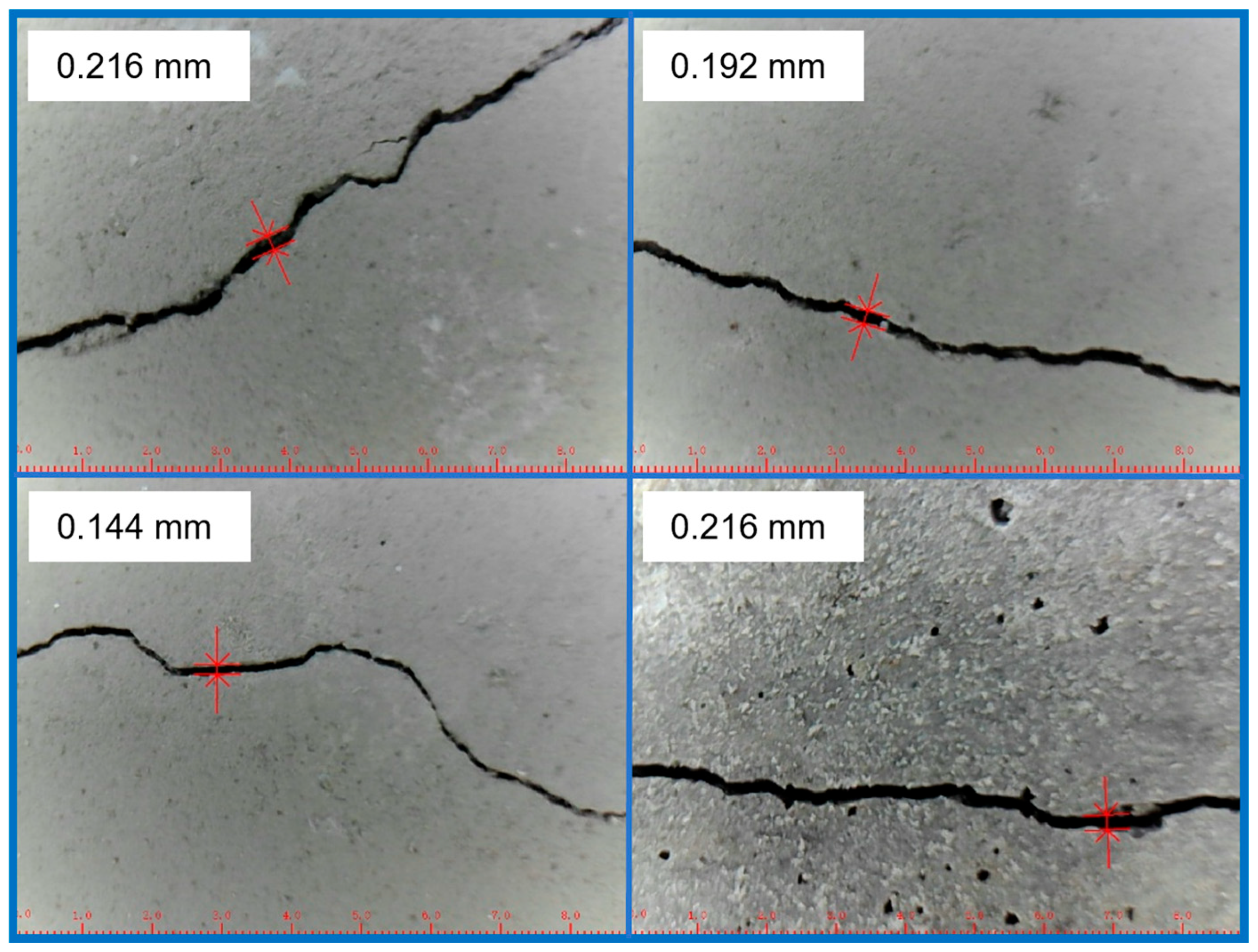



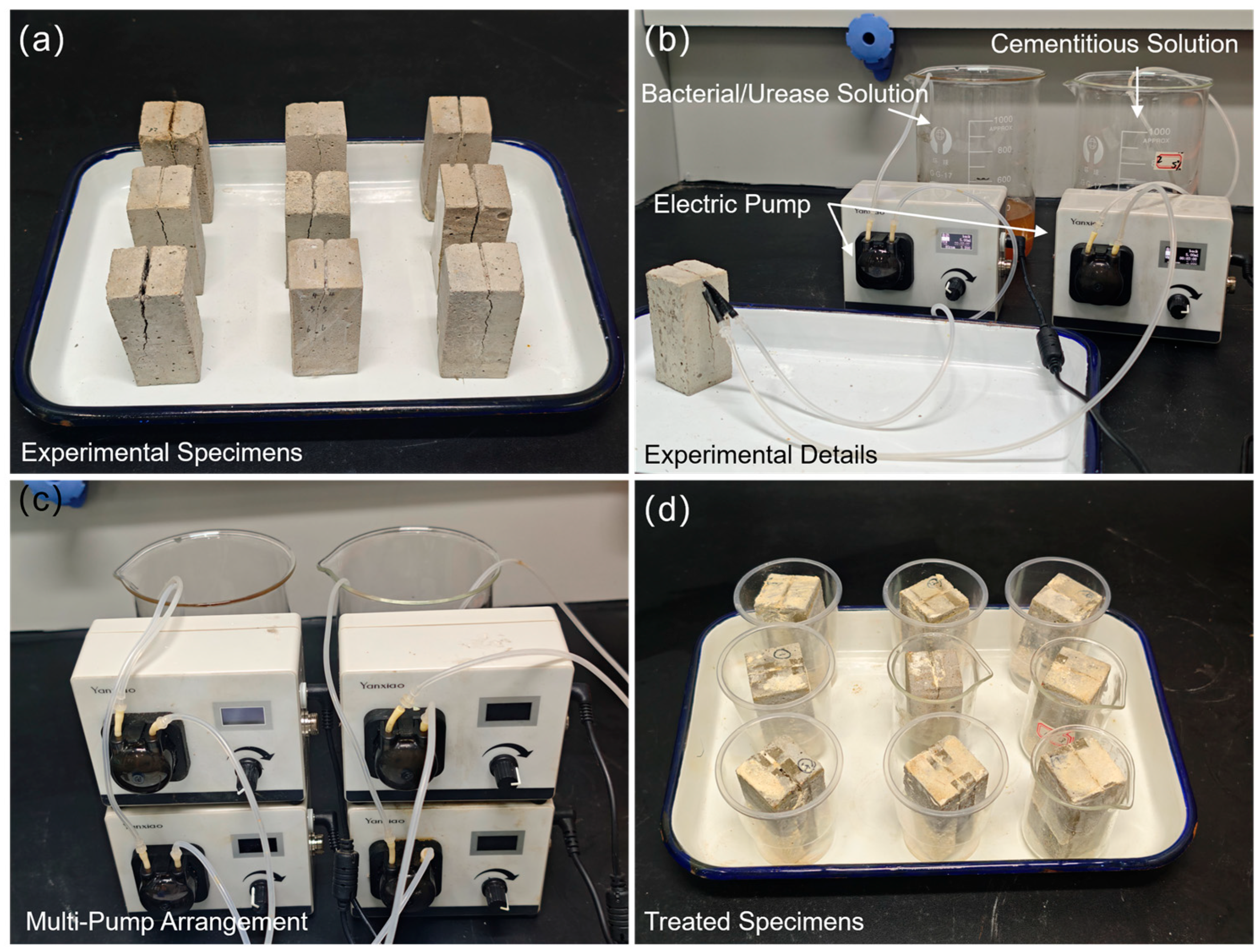

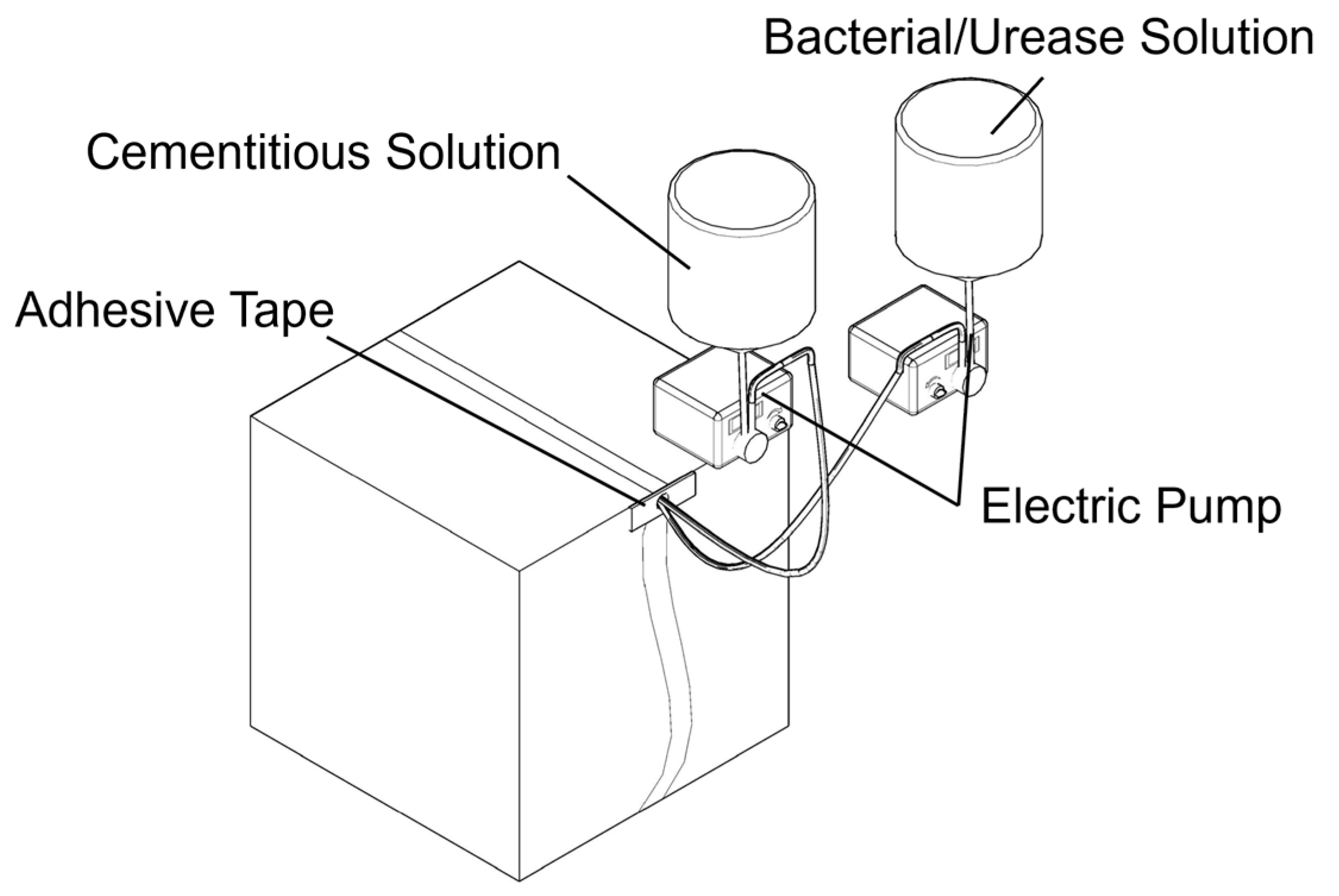


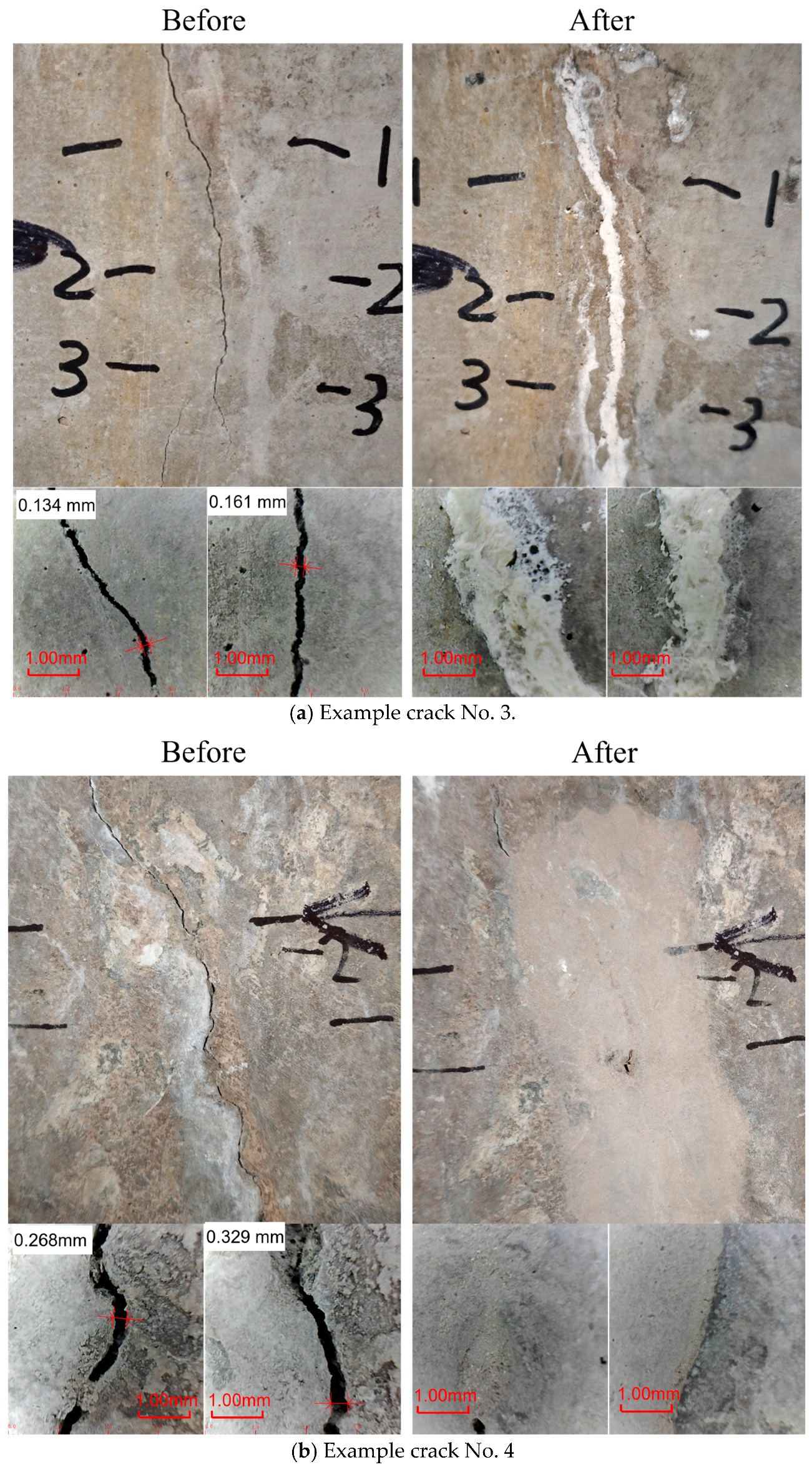
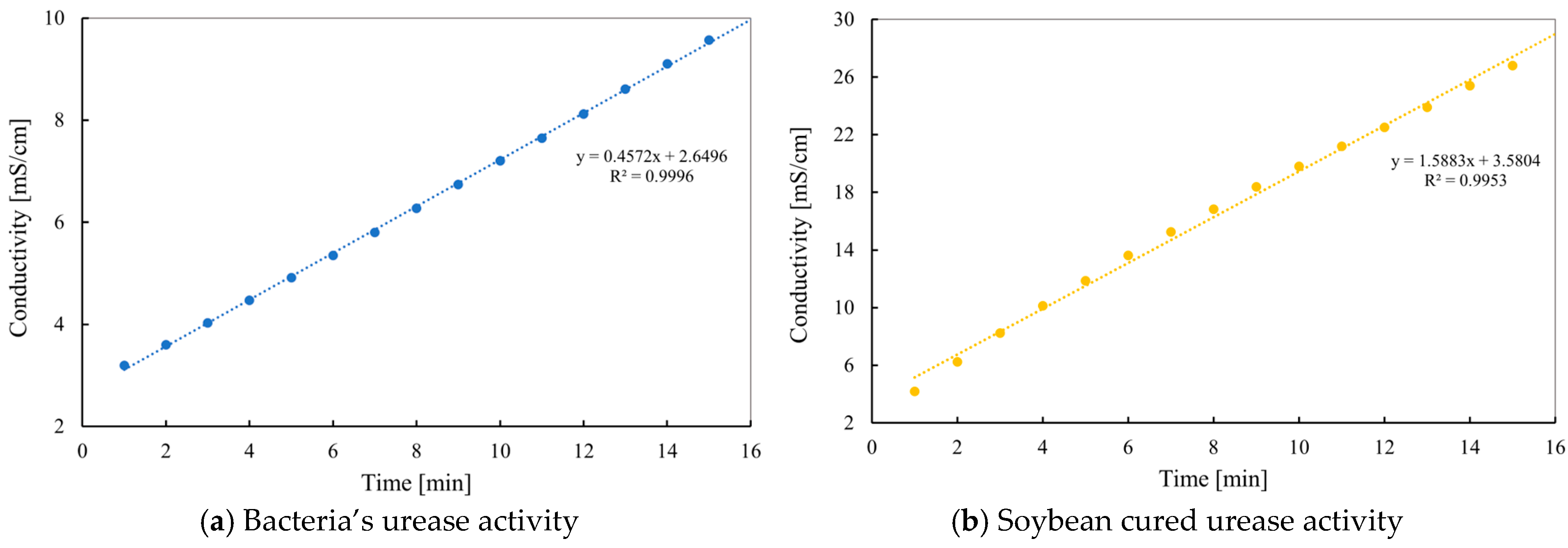
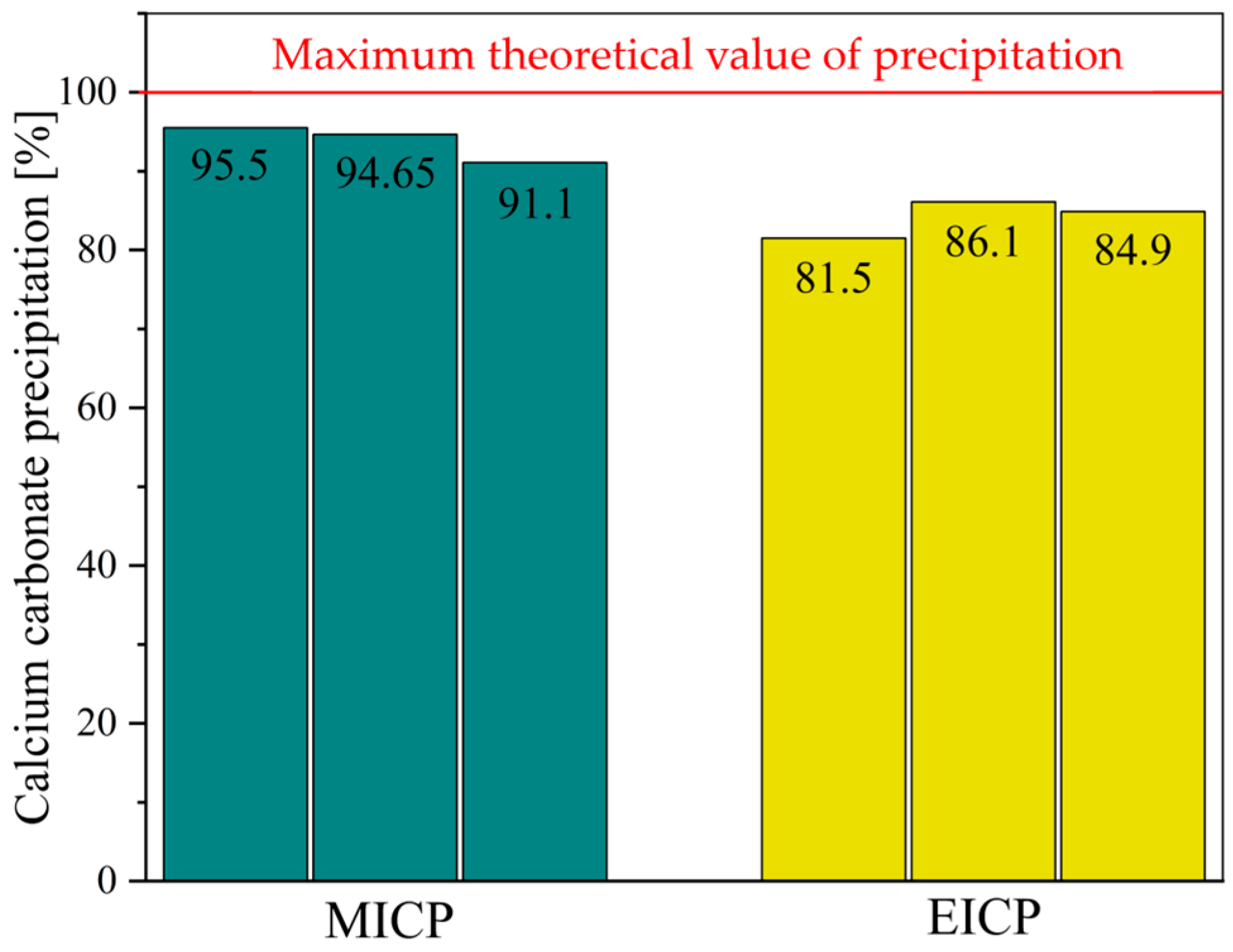
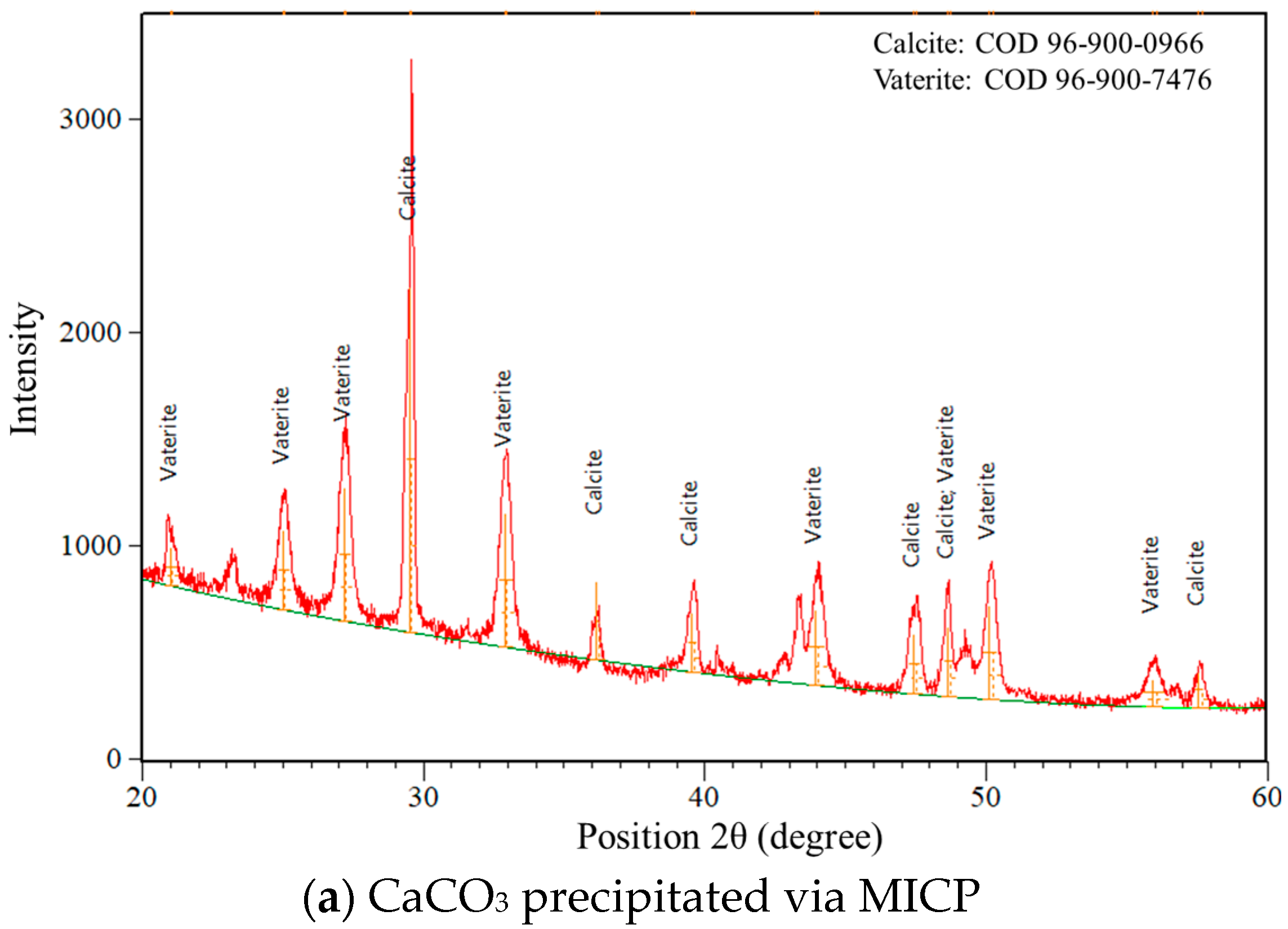


Disclaimer/Publisher’s Note: The statements, opinions and data contained in all publications are solely those of the individual author(s) and contributor(s) and not of MDPI and/or the editor(s). MDPI and/or the editor(s) disclaim responsibility for any injury to people or property resulting from any ideas, methods, instructions or products referred to in the content. |
© 2025 by the authors. Licensee MDPI, Basel, Switzerland. This article is an open access article distributed under the terms and conditions of the Creative Commons Attribution (CC BY) license (https://creativecommons.org/licenses/by/4.0/).
Share and Cite
Zhang, X.; Zhang, Y.; Luo, H.; Peng, B.; Zhang, Y.; Yao, J.; Jedrzejko, M.J. Experimental Study and Practical Application of Existing Crack Repair in Concrete Dam Tunnels Using MICP and EICP. Buildings 2025, 15, 3275. https://doi.org/10.3390/buildings15183275
Zhang X, Zhang Y, Luo H, Peng B, Zhang Y, Yao J, Jedrzejko MJ. Experimental Study and Practical Application of Existing Crack Repair in Concrete Dam Tunnels Using MICP and EICP. Buildings. 2025; 15(18):3275. https://doi.org/10.3390/buildings15183275
Chicago/Turabian StyleZhang, Xu, Yu Zhang, Huiheng Luo, Bo Peng, Yongzhi Zhang, Jiahui Yao, and Mateusz Jan Jedrzejko. 2025. "Experimental Study and Practical Application of Existing Crack Repair in Concrete Dam Tunnels Using MICP and EICP" Buildings 15, no. 18: 3275. https://doi.org/10.3390/buildings15183275
APA StyleZhang, X., Zhang, Y., Luo, H., Peng, B., Zhang, Y., Yao, J., & Jedrzejko, M. J. (2025). Experimental Study and Practical Application of Existing Crack Repair in Concrete Dam Tunnels Using MICP and EICP. Buildings, 15(18), 3275. https://doi.org/10.3390/buildings15183275





